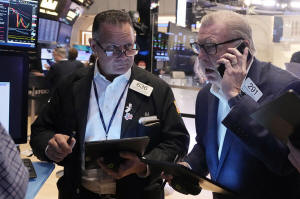Wall Street rises after encouraging inflation data, but the trade war
keeps knocking stocks around
[March 13, 2025] By
STAN CHOE
NEW YORK (AP) — U.S. stock indexes rose Wednesday after Wall Street got
some relief from an encouraging inflation update. But even on a rare up
day for the market, President Donald Trump’s trade war still knocked
stocks around.
The S&P 500 gained 0.5% after skidding between an early gain of 1.3% and
a later loss. The unsettled trading came a day after the index briefly
fell more than 10% below its all-time high set last month.
The Dow Jones Industrial Average also pinballed sharply, careening
between a rise of 287 points and a drop of 423. It ended with a loss of
82 points, or 0.2%, while the Nasdaq composite climbed 1.2%.
The inflation report, which showed overall prices rose less for U.S.
consumers last month than economists expected, helped companies in the
artificial-intelligence industry lead the way. It’s a bounce back after
AI stocks got crushed recently by worries their prices had gone too
stratospheric in the market’s run to record after record in recent
years.
Nvidia climbed 6.4% to trim its loss for the year so far to 13.8%.
Server-maker Super Micro Computer rose 4%, and GE Vernova, which is
helping to power AI data centers, gained 5.1%.
Elon Musk’s Tesla, whose price had more than halved since mid-December,
rallied 7.6% for its first back-to-back gain in nearly a month.
Even with such gains, though, more stocks in the S&P 500 fell than rose.
Among the hardest hit were businesses that could be set to feel pain
because of Trump’s trade war.

Brown-Forman, the company behind Jack Daniel’s whiskey, tumbled 5.1%,
and Harley-Davidson sank 5.7%.
U.S. bourbon and motorcycles are just two of the products the European
Union is targeting with its own tariffs announced on U.S. products. The
moves were in response to Trump’s 25% tariffs on steel and aluminum that
kicked in earlier in the day.
Canada also hit back with tariffs announced on U.S. tools, sports
equipment and other products.
“We deeply regret this measure,” European Union President Ursula von der
Leyen said. “Tariffs are taxes. They are bad for business, and worse for
consumers.”
The question hanging over Wall Street is how much pain Trump will let
the economy endure through tariffs and other policies. He’s said he
wants manufacturing jobs back in the United States, along with a smaller
U.S. government workforce, more deportations and other things.
Even if Trump ultimately goes with milder tariffs, damage could still be
done. The dizzying barrage of on -again, off -again announcements on
tariffs has already begun sapping confidence among U.S. consumers and
businesses by ramping up uncertainty. That could cause U.S. households
and businesses to pull back on spending, which would hurt the economy.
[to top of second column] |

Traders work on the floor of the New York Stock Exchange, Wednesday,
March 12, 2025. (AP Photo/Richard Drew)
 On Tuesday, for example, Trump said
he would double tariffs announced on Canadian steel and aluminum,
only to walk it back later in the day after a Canadian province
pledged to drop a retaliatory measure that had incensed Trump.
Several U.S. businesses have said they’ve already begun seeing a
change in behavior among their customers.
Delta Air Lines sank 3% to compound its drop of 7.3% from the prior
day, when the carrier said it’s seeing demand weaken for close-in
bookings for its flights.
Casey’s General Stores, the Ankeny, Iowa-based company that runs
nearly 2,900 convenience stores in 20 states, offered some
encouragement. It reported stronger profit and revenue for the
latest quarter than analysts expected thanks in part to strength for
sales of hot sandwiches and fuel. It also kept steady its forecast
for upcoming revenue this year.
Casey’s stock rose 6.2%.
All told, the S&P 500 rose 27.23 points to 5,599.30. The Dow Jones
Industrial Average fell 82.55 to 41,350.93, and the Nasdaq composite
jumped 212.35 to 17,648.45.
In stock markets abroad, indexes rose across much of Europe
following mixed sessions in Asia.
In the bond market, Treasury yields edged up to regain more of their
losses from recent months sparked by worries about the U.S.
economy’s strength. The 10-year Treasury rose to 4.31% from 4.28%
late Tuesday and from 4.16% at the start of last week.
Wednesday’s better-than-expected inflation report gave some
encouragement when worries are high that Trump’s tariffs could drive
prices even higher for U.S. households after U.S. importers pass on
the costs to their customers.
It’s also helpful for the Federal Reserve, which had been cutting
interest rates last year to boost the economy before pausing this
year, partly because of concerns about stubbornly high inflation.
Worries had been rising about a worst-case scenario for the economy
and for the Fed, where economic growth stagnates but inflation
remains high. The Fed has no good tool to fix such “stagflation”
because lower interest rates can push inflation higher.

“Trends that would suggest a cold economy and hot inflation are
still in the early stages, but uncertainty remains high,” according
to Phil Segner, senior research analyst at Leuthold.
Or, as Brian Jacobsen, chief economist at Annex Wealth Management,
said: “The tariff story is just beginning.”
___
AP Business Writer Yuri Kageyama contributed.
All contents © copyright 2025 Associated Press. All rights reserved |